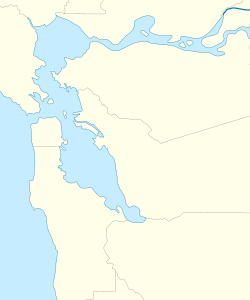
A | B | C | D | E | F | G | H | CH | I | J | K | L | M | N | O | P | Q | R | S | T | U | V | W | X | Y | Z | 0 | 1 | 2 | 3 | 4 | 5 | 6 | 7 | 8 | 9
Berkeley | |
|---|---|
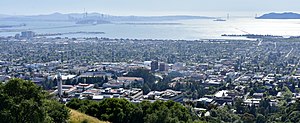 Looking west over the city from the Berkeley Hills, with San Francisco in the background | |
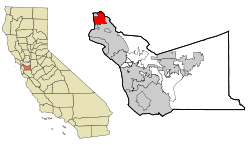 Location of Berkeley in Alameda County, California | |
| Coordinates: 37°52′18″N 122°16′22″W / 37.87167°N 122.27278°W | |
| Country | United States |
| State | California |
| County | Alameda |
| Incorporated | April 4, 1878[1] |
| Chartered | March 5, 1895[2] |
| Named for | George Berkeley |
| Government | |
| • Type | Council-Manager[2] |
| • Mayor | Jesse Arreguín[3] |
| • Council members by district number[3] |
|
| • State senator | Nancy Skinner (D)[4] |
| • Assembly member | Buffy Wicks (D)[5] |
| • U.S. rep. | Barbara Lee (D)[6] |
| Area | |
| • Total | 17.66 sq mi (45.73 km2) |
| • Land | 10.43 sq mi (27.02 km2) |
| • Water | 7.22 sq mi (18.71 km2) 40.83% |
| Elevation | 171 ft (52 m) |
| Population (2020) | |
| • Total | 124,321 |
| • Rank | |
| • Density | 11,917.27/sq mi (4,601.36/km2) |
| Demonym | Berkeleyan |
| Time zone | UTC−8 (Pacific) |
| • Summer (DST) | UTC−7 (PDT) |
| ZIP Codes[9] | 94701–94710, 94712, 94720 |
| Area code | 510, 341 |
| FIPS code | 06-06000 |
| GNIS feature IDs | 1658037, 2409837 |
| Website | berkeleyca |
Berkeley (/ˈbɜːrkli/ BURK-lee) is a city on the eastern shore of San Francisco Bay in northern Alameda County, California, United States. It is named after the 18th-century Anglo-Irish bishop and philosopher George Berkeley. It borders the cities of Oakland and Emeryville to the south and the city of Albany and the unincorporated community of Kensington to the north. Its eastern border with Contra Costa County generally follows the ridge of the Berkeley Hills. The 2020 census recorded a population of 124,321.
Berkeley is home to the oldest campus in the University of California, the University of California, Berkeley, and the Lawrence Berkeley National Laboratory, which is managed and operated by the university. It also has the Graduate Theological Union, one of the largest religious studies institutions in the world. Berkeley is considered one of the most socially progressive cities in the United States.
History
Indigenous history

The site of today's City of Berkeley was the territory of the Chochenyo/Huchiun Ohlone people when the first Europeans arrived.[10] Evidence of their existence in the area include pits in rock formations, which they used to grind acorns, and a shellmound, now mostly leveled and covered up, along the shoreline of San Francisco Bay at the mouth of Strawberry Creek. Human remains and skeletons from Native American burials have been unearthed in West Berkeley and on campus alongside Strawberry Creek.[11][12] Other artifacts were discovered in the 1950s in the downtown area during remodeling of a commercial building, near the upper course of the creek.
Spanish and Mexican eras
The first people of European descent (most of whom were of mixed race and born in America[13]) arrived with the De Anza Expedition in 1776.[14] The De Anza Expedition led to establishment of the Spanish Presidio of San Francisco at the entrance to San Francisco Bay (the "Golden Gate)." Luis Peralta was among the soldiers at the Presidio. For his services to the King of Spain, he was granted a vast stretch of land on the east shore of San Francisco Bay (the contra costa, "opposite shore") for a ranch, including that portion that now comprises the City of Berkeley.
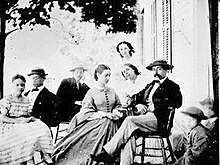
Luis Peralta named his holding "Rancho San Antonio." The primary activity of the ranch was raising cattle for meat and hides, but hunting and farming were also pursued. Eventually, Peralta gave portions of the ranch to each of his four sons. What is now Berkeley lies mostly in the portion that went to Peralta's son Domingo, with a little in the portion that went to another son, Vicente. No artifact survives of the Domingo or Vicente ranches, but their names survive in Berkeley street names (Vicente, Domingo, and Peralta). However, legal title to all land in the City of Berkeley remains based on the original Peralta land grant.
The Peraltas' Rancho San Antonio continued after Alta California passed from Spanish to Mexican sovereignty after the Mexican War of Independence. However, the advent of U.S. sovereignty after the Mexican–American War, and especially, the Gold Rush, saw the Peraltas' lands quickly encroached on by squatters and diminished by dubious legal proceedings. The lands of the brothers Domingo and Vicente were quickly reduced to reservations close to their respective ranch homes. The rest of the land was surveyed and parceled out to various American claimants (See Kellersberger's Map).
Politically, the area that became Berkeley was initially part of a vast Contra Costa County. On March 25, 1853, Alameda County was created from a division of Contra Costa County, as well as from a small portion of Santa Clara County. The area that became Berkeley was then the northern part of the "Oakland Township" subdivision of Alameda County. During this period, "Berkeley" was mostly a mix of open land, farms, and ranches, with a small, though busy, wharf by the bay.
Late 19th century

In 1866, Oakland's private College of California looked for a new site. It settled on a location north of Oakland along the foot of the Contra Costa Range (later called the Berkeley Hills) on Strawberry Creek, at an elevation of about 500 feet (150 m) above the bay, commanding a view of the Bay Area and the Pacific Ocean through the Golden Gate.
According to the Centennial Record of the University of California, "In 1866, at Founders' Rock, a group of College of California men watched two ships standing out to sea through the Golden Gate. One of them, Frederick Billings, thought of the lines of the Anglo-Irish Anglican Bishop George Berkeley, 'westward the course of empire takes its way,' and suggested that the town and college site be named for the eighteenth-century Anglo-Irish philosopher."[15] The philosopher's name is pronounced BARK-lee, but the city's name, to accommodate American English, is pronounced BERK-lee.[16]
The College of California's College Homestead Association planned to raise funds for the new campus by selling off adjacent parcels of land. To this end, they laid out a plat and street grid that became the basis of Berkeley's modern street plan. Their plans fell far short of their desires, and they began a collaboration with the State of California that culminated in 1868 with the creation of the public University of California.


As construction began on the new site, more residences were constructed in the vicinity of the new campus. At the same time, a settlement of residences, saloons, and various industries grew around the wharf area called Ocean View. A horsecar ran from Temescal in Oakland to the university campus along what is now Telegraph Avenue. The first post office opened in 1872.[17]
By the 1870s, the Transcontinental Railroad reached its terminus in Oakland. In 1876, a branch line of the Central Pacific Railroad, the Berkeley Branch Railroad, was laid from a junction with the mainline called Shellmound (now a part of Emeryville) into what is now downtown Berkeley. That same year, the mainline of the transcontinental railroad into Oakland was re-routed, putting the right-of-way along the bay shore through Ocean View.
There was a strong prohibition movement in Berkeley at this time. In 1876, the state enacted the "mile limit law", which forbade sale or public consumption of alcohol within one mile (1.6 km) of the new University of California.[18] Then, in 1899, Berkeley residents voted to make their city an alcohol-free zone. Scientists, scholars and religious leaders spoke vehemently of the dangers of alcohol.[19]
On April 1, 1878, the people of Ocean View and the area around the university campus, together with local farmers, were granted incorporation by the State of California as the Town of Berkeley.[20] The first elected trustees of the town were the slate of Denis Kearney's anti-Chinese Workingman's Party, who were particularly favored in the working-class area of the former Ocean View, now called West Berkeley. During the 1880s Berkeley had segregated housing and anti-Chinese laws.[21] The area near the university became known for a time as East Berkeley.
Due to the influence of the university, the modern age came quickly to Berkeley. Electric lights and the telephone were in use by 1888. Electric streetcars soon replaced the horsecar. A silent film of one of these early streetcars in Berkeley can be seen at the Library of Congress website.[22]
Early 20th century

Berkeley's slow growth ended abruptly with the Great San Francisco earthquake of 1906. The town and other parts of the East Bay escaped serious damage, and thousands of refugees flowed across the Bay. Among them were most of San Francisco's painters and sculptors, who between 1907 and 1911 created one of the largest art colonies west of Chicago. Artist and critic Jennie V. Cannon described the founding of the Berkeley Art Association and the rivalries of competing studios and art clubs.[23]
In 1904, the first hospitals in Berkeley were created: the Alta Bates Sanatorium (today Alta Bates Summit Medical Center) for women and children, founded by nurse Alta Bates on Walnut Street, and the Roosevelt Hospital (later Herrick Hospital), founded by LeRoy Francis Herrick, on the corner of Dwight Way and Milvia Street.[24][25]
In 1908, a statewide referendum that proposed moving the California state capital to Berkeley was defeated by a margin of about 33,000 votes.[26] The city had named streets around the proposed capitol grounds for California counties. They bear those names today, a legacy of the failed referendum.

On March 4, 1909, following public referendums, the citizens of Berkeley were granted a new charter by the State of California, and the Town of Berkeley became the City of Berkeley.[27] Rapid growth continued up to the Crash of 1929. The Great Depression hit Berkeley hard, but not as hard as many other places in the U.S., thanks in part to the university.
In 1916, Berkeley implemented single-family zoning as an effort to keep minorities out of white neighborhoods. This has been described as the first implementation of single-family zoning in the United States[28][29][30] By 2021, nearly half of Berkeley's residential neighborhoods were still exclusively zoned for single-family homes.[31]
On September 17, 1923, a major fire swept down the hills toward the university campus and the downtown section. Around 640 structures burned before a late-afternoon sea breeze stopped its progress, allowing firefighters to put it out.
The next big growth occurred with the advent of World War II, when large numbers of people moved to the Bay Area to work in the many war industries, such as the immense Kaiser Shipyards in nearby Richmond. One who moved out, but played a big role in the outcome of the war, was U.C. professor and Berkeley resident J. Robert Oppenheimer. During the war, an Army base, Camp Ashby, was temporarily sited in Berkeley.
The element berkelium was synthesized utilizing the 60-inch (1.5 m) cyclotron at UC Berkeley, and named in 1949, in recognition of the university, thus placing the city's name in the list of elements.
1940–60s

During the 1940s, many African Americans migrated to Berkeley.[32] In 1950, the Census Bureau reported Berkeley's population as 11.7% black and 84.6% white.[33]
The postwar years brought moderate growth to the city, as events on the U.C. campus began to build up to the recognizable activism of the sixties. In the 1950s, McCarthyism induced the university to demand a loyalty oath from its professors, many of whom refused to sign the oath on the principle of freedom of thought. In 1960, a U.S. House committee (HUAC) came to San Francisco to investigate the influence of communists in the Bay Area. Their presence was met by protesters, including many from the university. Meanwhile, a number of U.C. students became active in the civil rights movement. Finally, in 1964, the university provoked a massive student protest by banning distribution of political literature on campus. This protest became the Free Speech Movement. As the Vietnam War rapidly escalated in the ensuing years, so did student activism at the university, particularly that organized by the Vietnam Day Committee.
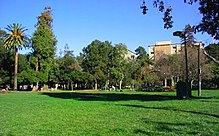
Berkeley is strongly identified with the rapid social changes, civic unrest, and political upheaval that characterized the late 1960s.[34] In that period, Berkeley—especially Telegraph Avenue—became a focal point for the hippie movement, which spilled over the Bay from San Francisco. Many hippies were apolitical drop-outs, rather than students, but in the heady atmosphere of Berkeley in 1967–1969 there was considerable overlap between the hippie movement and the radical left. An iconic event in the Berkeley Sixties scene was a conflict over a parcel of university property south of the contiguous campus site that came to be called "People's Park".
The battle over the disposition of People's Park resulted in a month-long occupation of Berkeley by the National Guard on orders of then-Governor Ronald Reagan. In the end, the park remained undeveloped, and remains so today. A spin-off, People's Park Annex, was established at the same time by activist citizens of Berkeley on a strip of land above the Bay Area Rapid Transit ("BART") underground construction along Hearst Avenue northwest of the U.C. campus. The land had also been intended for development, but was turned over to the city by BART and is now Ohlone Park.
The era of large public protest in Berkeley waned considerably with the end of the Vietnam War in 1975. While the 1960s were the heyday of liberal activism in Berkeley, it remains one of the most overwhelmingly Democratic cities in the United States.
1970s and 1980s
Housing and zoning changes
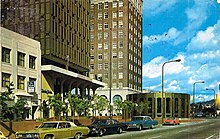
After the 1960s, Berkeley banned most new housing construction, in particular apartments.[35]
Increasing enrollment at the university led to replacement of older buildings by large apartment buildings, especially in older parts of the city near the university and downtown. Increasing enrollment also led the university to wanting to redevelop certain places of Berkeley, especially Southside, but more specifically People's Park.[36] Preservationists passed the Neighborhood Protection Ordinance in 1973 by ballot measure and the Landmarks Preservation Ordinance in 1974 by the City Council. Together, these ordinances brought most new construction to a halt.[37] Facing rising housing costs, residents voted to enact rent control and vacancy control in 1980.[38] Though more far-reaching in their effect than those of some of the other jurisdictions in California that chose to use rent control where they could, these policies were limited by the Costa-Hawkins Rental Housing Act, a statewide ban on rent control that came into effect in 1995 and limited rent control to multi-family units that were built (or technically buildings that were issued their original certificate of occupation) before the state law came into effect in 1995. For cities such as Berkeley, where rent control was already in place, the law limited the use of rent control to units built before the local rent-control law was enacted, i.e. 1980.[39]
Political movements
During the 1970s and 1980s, activists increased their power in local government. This era also saw major developments in Berkeley's environmental and food culture. Berkeley's last Republican mayor, Wallace J. S. Johnson, left office in 1971. Alice Waters opened Chez Panisse in 1971. The first curbside recycling program in the U.S. was started by the Ecology Center in 1973. Styrofoam was banned in 1988.[40]
As the city leaned more and more Democratic, local politics became divided between "Progressives" and "Moderates". 1984 saw the Progressives take the majority for the first time. Nancy Skinner became the first UC Berkeley student elected to City Council. In 1986, in reaction to the 1984 election, a ballot measure switched Berkeley from at-large to district-based elections for city council.[41]
In 1983, Berkeley's Domestic Partner Task Force was established, which in 1984 made policy recommendation to the school board, which passed domestic partner legislation. The legislation became a model for similar measures nationwide.[42]
1990s and 2000s

In 1995, California's Costa–Hawkins Act ended vacancy control, allowing rents to increase when a tenant moved out. Despite a slow down in 2005–2007, median home prices and rents remain dramatically higher than the rest of the nation,[43] fueled by spillover from the San Francisco housing shortage and population growth.
South and West Berkeley underwent gentrification, with some historically Black neighborhoods such as the Adeline Corridor seeing a 50% decline in Black / African American population from 1990 to 2010.[44] In the 1990s, public television's Frontline documentary series featured race relations at Berkeley's only public high school, Berkeley High School.[45]
With an economy dominated by the University of California and a high-demand housing market, Berkeley was relatively unaffected by the Great Recession. State budget cuts caused the university to increase the number of out-of-state and international students, with international enrollment, mostly from Asia, rising from 2,785 in 2007 to 5,951 in 2016.[46] Since then, more international restaurants have opened downtown and on Telegraph Avenue, including East Asian chains such as Ippudo and Daiso.
A wave of downtown apartment construction began in 1998.[47]
In 2006, the Berkeley Oak Grove Protest began protesting construction of a new sports center annex to Memorial Stadium at the expense of a grove of oak trees on the UC campus. The protest ended in September 2008 after a lengthy court process.
In 2007–2008, Berkeley received media attention due to demonstrations against a Marine Corps recruiting office in downtown Berkeley and a series of controversial motions by Berkeley's city council regarding opposition to Marine recruiting. (See Berkeley Marine Corps Recruiting Center controversy.)
2010s and 2020s
During the fall of 2010, the Berkeley Student Food Collective opened after many protests on the UC Berkeley campus due to the proposed opening of the fast food chain Panda Express. Students and community members worked together to open a collectively run grocery store right off of the UC Berkeley campus, where the community can buy local, seasonal, humane, and organic foods. The Berkeley Student Food Collective still operates at 2440 Bancroft Way.
On September 18, 2012, Berkeley became what may be the first city in the U.S. to officially proclaim a day recognizing bisexuals: September 23, which is known as Celebrate Bisexuality Day.[48]
On September 2, 2014, the city council approved a measure to provide free medical marijuana to low-income patients.[49]
The Measure D soda tax was approved by Berkeley voters on November 4, 2014, the first such tax in the United States.[50]
Protests
In the fall of 2011, the nationwide Occupy Wall Street movement came to two Berkeley locations: on the campus of the University of California and as an encampment in Civic Center Park.
During a Black Lives Matter protest on December 6, 2014, police use of tear gas and batons to clear protesters from Telegraph Avenue led to a riot and five consecutive days and nights of protests, marches, and freeway occupations in Berkeley and Oakland.[51] Afterwards, changes were implemented by the Police Department to avoid escalation of violence and to protect bystanders during protests.[52]
During a protest against bigotry and U.S. President Donald Trump in August 2017, anti-fascist protesters grew violent against Trump supporters in attendance. Police intervened, arresting 14 people. Sometimes called "antifa", these anti-fascist activists were clad in all black, while some carried shields and others had masks or bandanas hiding their faces.[53] These protests spanned February to September 2017 (See more at 2017 Berkeley Protests).[54]
In 2019, protesters took up residence in People's Park against tree-chopping and were arrested by police in riot gear. Many activists saw this as the university preparing to develop the park.[55]
Homelessness
The city of Berkeley has historically been a central location for homeless communities in the Bay Area.[56] Since the 1930s, the city of Berkeley has fostered a tradition of political activism.[57] The city has been perceived as a hub for liberal thought and action and it has passed ordinances to oust homeless individuals from Berkeley on multiple occasions.[58] Despite efforts to remove unhoused individuals from the streets and projects to improve social service provision for this demographic, homelessness has continued to be a significant problem in Berkeley.[59]
1960s
A culture of anti-establishment and sociopolitical activism marked the 1960s.[57] The San Francisco Bay Area became a hotspot for hippie counterculture, and Berkeley became a haven for nonconformists and anarchists[57] from all over the United States.[60] Most public discourse around homelessness in Berkeley at this time was centered around the idea of street-living as an expression of counterculture.[56]
During the Free Speech Movement in the fall of 1964, Berkeley became a hub of civil unrest, with demonstrators and UC Berkeley students sympathizing with the statewide protests for free speech and assembly, as well as revolting against university restrictions against student political activities and organizations established by UC President Clark Kerr in 1959. Many non-student youth and adolescents sought alternative lifestyles and opted for voluntary homelessness during this time.[61][62]
In 1969, People's Park was created and eventually became a haven for "small-time drug dealers, street people, and the homeless".[63] Although the City of Berkeley has moved unhoused individuals from its streets, sometimes even relocating them to an unused landfill, People's Park has remained a safe space for them since its inception.[63] The park has become one of the few relatively safe spaces for homeless individuals to congregate in Berkeley and the greater Bay Area.[63]
1970s
Stereotypes of homeless people as deviant individuals who chose to live vagrant lifestyles continued to color the discourse around street-dwellers in American cities.[56] However, this time period was also characterized by a subtle shift in the perception of unhoused individuals. The public began to realize that homelessness affected not only single men, but also women, children, and entire families.[56] This recognition set the stage for the City of Berkeley's attitude towards homelessness in the next decade.[64]
1980s
Organizations such as Building Opportunities for Self Sufficiency (BOSS) were established in 1971 in response to the needs of individuals with mental illness being released to the streets by state hospital closures.[65]
1990s
In the 1990s, the City of Berkeley faced a substantial increase in the need for emergency housing shelters and saw a rise in the average amount of time individuals spent without stable housing.[58] As housing became a more widespread problem, the general public, Berkeley City Council, and the University of California became increasingly anti-homeless in their opinions.[58] In 1994, Berkeley City Council considered the implementation of a set of anti-homeless laws that the San Francisco Chronicle described as being "among the strictest in the country".[56] These laws prohibited sitting, sleeping and begging in public spaces, and outlawed panhandling from people in a variety of contexts, such as sitting on public benches, buying a newspaper from a rack, or waiting in line for a movie.[56] In February 1995, the American Civil Liberties Union (ACLU) sued the city for infringing free speech rights through its proposed anti-panhandling law.[56] In May of that same year, a federal judge ruled that the anti-panhandling law did violate the First Amendment, but left the anti-sitting and sleeping laws untouched.[56]
Following the implementation of these anti-sitting and sleeping ordinances in 1998, Berkeley increased its policing of homeless adults and youth, particularly in the shopping district surrounding Telegraph Avenue.[66] The mayor at that time, Shirley Dean, proposed a plan to increase both social support services for homeless youth and enforcement of anti-encampment laws.[66] Unhoused youth countered this plan with a request for the establishment of the city's first youth shelter, more trash cans, and more frequent cleaning of public bathrooms.[66]
21st century
The City of Berkeley's 2017 annual homeless report and point-in-time count (PIT) estimate that on a given night, 972 people are homeless.[67] Sixty-eight percent (664 people) of these individuals are also unsheltered, living in places not considered suitable for human habitation, such as cars or streets.[67] Long-term homelessness in Berkeley is double the national average, with 27% of the city's homeless population facing chronic homelessness.[67] Chronic homelessness has been on the rise since 2015, and has been largely a consequence of the constrained local housing market.[67] In 2015, rent in Alameda County increased by 25%, while the average household income only grew by 5%.[68] The City of Berkeley's 2017 report also estimated the number of unaccompanied youth in Berkeley at 189 individuals, 19% of the total homeless population in the city. Homeless youth display greater risk of mental health issues, behavioral problems, and substance abuse, than any other homeless age group.[62] Furthermore, homeless youth identifying as LGBTQ+ are exposed to greater rates of physical and sexual abuse, and higher risk for sexually-transmitted diseases, predominantly HIV.[69][70]
The City of Berkeley has seen a consistent rise in the number of chronically homeless individuals over the past 30 years, and has implemented a number of different projects to reduce the number of people living on the streets.[71] In 2008, the City focused its efforts on addressing chronic homelessness. This led to a 48% decline in the number of chronically homeless individuals reported in the 2009 Berkeley PIT.[72] However, the number of "hidden homeless" individuals (those coping with housing insecurity by staying at a friend or relative's residence), increased significantly, likely in response to rising housing costs and costs of living.[72] In 2012, the City considered measures that banned sitting in commercial areas throughout Berkeley.[72] The measure was met with strong public opposition and did not pass. However, the City saw a strong need for it to implement rules addressing encampments and public usage of space as well as assessing the resources needed to assist the unhoused population.[72] In response to these needs the City of Berkeley established the Homeless Task Force, headed by then-Councilmember Jesse Arreguín.[72] Since its formation, the Task Force has proposed a number of different recommendations, from expanding the City Homeless Outreach and Mobile Crisis Teams, to building a short-term transitional shelter for unhoused individuals.[73]
Geography
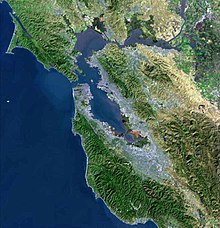
According to the United States Census Bureau, the city's 17.7-square-mile (46 km2) area includes 10.5 square miles (27 km2) of land and 7.2 square miles (19 km2) (40.83%) water, most of it part of San Francisco Bay.
Berkeley borders the cities of Albany, Oakland, and Emeryville and Contra Costa County, including unincorporated Kensington, as well as San Francisco Bay.
Berkeley lies within telephone area code 510 (until September 2, 1991, Berkeley was part of the 415 telephone code that now covers only San Francisco and Marin counties[74]), and the postal ZIP codes are 94701 through 94710, 94712, and 94720 for the University of California campus.[9]
Geology
Most of Berkeley lies on a rolling sedimentary plain that rises gently from sea level to the base of the Berkeley Hills. East of the Hayward Fault along the base of the hills, elevation increases more rapidly. The highest peak along the ridge line above Berkeley is Grizzly Peak, at an elevation of 1,754 feet (535 m). A number of small creeks run from the hills to the Bay through Berkeley: Cerrito, Codornices, Schoolhouse, and Strawberry Creeks are the principal streams. Most of these are largely culverted once they reach the plain west of the hills.
The Berkeley Hills are part of the Pacific Coast Ranges, and run in a northwest–southeast alignment. Exposed in the Berkeley Hills are cherts and shales of the Claremont Formation (equivalent to the Monterey Formation), conglomerate and sandstone of the Orinda Formation and lava flows of the Moraga Volcanics. Of similar age to the Moraga Volcanics (extinct), within the Northbrae neighborhood of Berkeley, are outcroppings of erosion resistant rhyolite. These rhyolite formations can be seen in several city parks and in the yards of a number of private residences. Indian Rock Park in the northeastern part of Berkeley near the Arlington/Marin Circle features a large example.
Earthquakes
Berkeley is traversed by the Hayward Fault Zone, a major branch of the San Andreas Fault to the west. No large earthquake has occurred on the Hayward Fault near Berkeley in historic times (except possibly in 1836), but seismologists warn about the geologic record of large temblors several times in the deeper past. The current assessment is that a Bay Area earthquake of magnitude 6.7 or greater within the next 30 years is likely, with the Hayward Fault having the highest likelihood among faults in the Bay Area of being the epicenter.[75] Moreover, like much of the Bay Area, Berkeley has many areas of some risk to soil liquefaction, with the flat areas closer to the shore at low to high susceptibility.[76]
The 1868 Hayward earthquake did occur on the southern segment of the Hayward Fault[77] in the vicinity of today's city of Hayward. This quake destroyed the county seat of Alameda County then located in San Leandro and it subsequently moved to Oakland. It was strongly felt in San Francisco, causing major damage. It was regarded as the "Great San Francisco earthquake" prior to 1906. It produced a furrow in the ground along the fault line in Berkeley, across the grounds of the new State Asylum for the Deaf, Dumb and Blind then under construction, which was noted by one early University of California professor. Although no significant damage was reported to most of the few Berkeley buildings of the time, the 1868 quake did destroy the vulnerable adobe home of Domingo Peralta in north Berkeley.[78]
Today, evidence of the Hayward Fault's "creeping" is visible at various locations in Berkeley. Cracked roadways, sharp jogs in streams, and springs mark the fault's path. However, since it cuts across the base of the hills, the creep is often concealed by or confused with slide activity. Some of the slide activity itself, however, results from movement on the Hayward Fault.
A notorious segment of the Hayward Fault runs lengthwise down the middle of Memorial Stadium at the mouth of Strawberry Canyon on the University of California campus.[79] Photos and measurements show the movement of the fault through the stadium.[80]
Climate
Berkeley has a warm-summer Mediterranean climate (Csb in the Köppen climate classification), with warm, dry summers and cool, wet winters. Berkeley's location directly opposite the Golden Gate ensures that typical eastward fog flow blankets the city more often than its neighbors.[81] The summers are cooler than a typical Mediterranean climate thanks to upwelling ocean currents along the California coast. These help produce cool and foggy nights and mornings.
Winter is punctuated with rainstorms of varying ferocity and duration, but also produces stretches of bright sunny days and clear cold nights. It does not normally snow, though occasionally the hilltops get a dusting. Spring and fall are transitional and intermediate, with some rainfall and variable temperature. Summer typically brings night and morning low clouds or fog, followed by sunny, warm days. The warmest and driest months are typically June through September, with the highest temperatures occurring in September. Mid-summer (July–August) is often a bit cooler due to the sea breezes and fog common then.
In a year, there are an average of 2.9 days with highs of 90 °F (32 °C) or higher, and an average of 0.8 days with lows of 32 °F (0 °C) or lower. The highest recorded temperature was 107 °F (42 °C) on June 15, 2000, and July 16, 1993, and the lowest recorded temperature was 24 °F (−4 °C) on December 22, 1990.
February is normally the wettest month, averaging 5.21 inches (132 mm) of precipitation. Average annual precipitation is 25.40 inches (645 mm), falling on an average of 63.7 days each year. The most rainfall in one month was 14.49 inches (368 mm) in February 1998. The most rainfall in 24 hours was 6.98 inches (177 mm) on January 4, 1982.[82] As in most of California, the heaviest rainfall years are usually associated with warm water El Niño episodes in the Pacific (e.g., 1982–83; 1997–98), which bring in drenching "Pineapple Express" storms. In contrast, dry years are often associated with cold Pacific La Niña episodes. Light snow has fallen on rare occasions. Snow has generally fallen every several years on the higher peaks of the Berkeley Hills.[83]
In the late spring and early fall, strong offshore winds of sinking air typically develop, bringing heat and dryness to the area. In the spring, this is not usually a problem as vegetation is still moist from winter rains, but extreme dryness prevails by the fall, creating a danger of wildfires. In September 1923, a major fire swept through the neighborhoods north of the university campus, stopping just short of downtown. On October 20, 1991, gusty, hot winds fanned a conflagration along the Berkeley–Oakland border, killing 25 people and injuring 150, as well as destroying 2,449 single-family dwellings and 437 apartment and condominium units.
| Climate data for Berkeley, California (1991–2020 normals, extremes 1893–present) | |||||||||||||
|---|---|---|---|---|---|---|---|---|---|---|---|---|---|
| Month | Jan | Feb | Mar | Apr | May | Jun | Jul | Aug | Sep | Oct | Nov | Dec | Year |
| Record high °F (°C) | 78 (26) |
81 (27) |
87 (31) |
95 (35) |
101 (38) |
107 (42) |
99 (37) |
104 (40) |
106 (41) |
99 (37) |
86 (30) |
78 (26) |
107 (42) |
| Mean maximum °F (°C) | 66.7 (19.3) |
72.1 (22.3) |
77.1 (25.1) |
82.0 (27.8) |
86.0 (30.0) |
90.9 (32.7) |
87.1 (30.6) |
89.0 (31.7) |
91.7 (33.2) |
87.6 (30.9) |
76.4 (24.7) |
66.5 (19.2) |
95.6 (35.3) |
| Mean daily maximum °F (°C) | 58.9 (14.9) |
61.6 (16.4) |
64.6 (18.1) |
67.3 (19.6) |
70.0 (21.1) |
74.1 (23.4) |
74.2 (23.4) |
74.7 (23.7) |
76.3 (24.6) |
73.4 (23.0) |
65.2 (18.4) |
58.6 (14.8) |
68.2 (20.1) |
| Daily mean °F (°C) | 51.1 (10.6) |
53.0 (11.7) |
55.2 (12.9) |
57.0 (13.9) |
59.7 (15.4) |
62.9 (17.2) |
63.7 (17.6) |
64.4 (18.0) |
64.9 (18.3) |
62.5 (16.9) |
56.1 (13.4) |
50.9 (10.5) |
58.5 (14.7) |
| Mean daily minimum °F (°C) | 43.3 (6.3) |
44.5 (6.9) |
45.9 (7.7) |
46.7 (8.2) |
Zdroj:https://en.wikipedia.org?pojem=History_of_Berkeley,_California|||||||||




